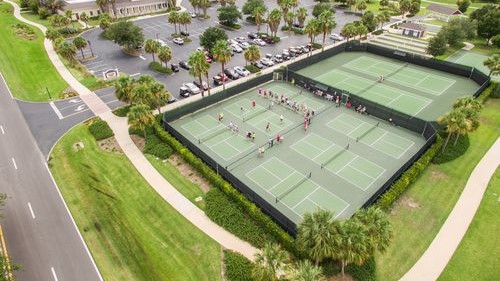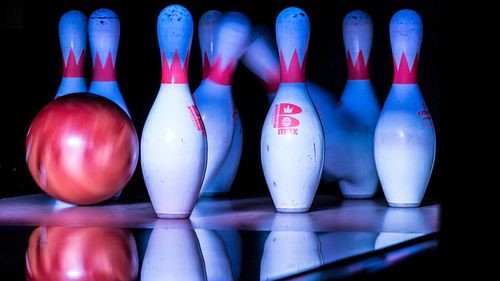Do you like net sports, such as tennis, badminton, and ping pong? If you do, then pickleball might be the game for you. Pickleball is a fairly new sport that combines many features of all three. It is played with a paddle and a plastic ball. It is played on a court (either indoor or outdoor) that is about the size of that used for badminton. A low net, similar to one used on a tennis court, separates the players on opposite sides.
The first question most people ask is, “How did pickleball start?” Pickleball was invented in 1965 as a game that all family members could play. The inventors were two dads from Washington state. They had been out playing golf on a summer day. They returned home to find their kids sitting around, bored and looking for something to do. They told the kids to go find their old ping pong paddles. They headed out to a local badminton court. They tried to hit a light plastic ball over the high net. Later they discovered that, by lowering the net to the ground, they could bounce the ball on the hard surface of the court. Before they knew it, the mix of adults and kids had a pretty exciting game going on.
A week later, another dad joined the group. Together, the three of them drew up some rules. They focused on the new game’s primary goal — to involve the whole family in a competitive but fun activity. An official court was constructed. A few years later, a national newspaper and a tennis magazine published articles about “America’s newest racquet sport.”
The second question most people ask is, “How did pickleball get its name?” Believe it or not, the sport has no connection to pickles. One theory suggests the sport was named for the dog of one of the inventors. However, it seems that the dog joined the family after the game was started. In fact, the dog may have been named for the game.
Another theory says the name came from a term used in the rowing sport of crew, since the wife of one of the inventors was a frequent rower. This might make sense. In crew, a rowing team that is made up of the leftover rowers from other boats is called a “pickle boat.” Since the new sport used leftover odds and ends from three other sports, it would have been organized in the same random way.
However, the strange name hasn’t hurt the popularity of the sport. If anything, it seems to make people more curious about the game. “There is something about the name,” said Hillary Brown, a YMCA Fitness Director. “It interests people and catches their attention.” According to pickleball ambassador Lisa Brochetti, “You get a good sweat. You’re active. It’s fun and really enjoyable. It’s competitive, but there’s friendship.”
Pickleball can be played with either ‘singles’ or ‘doubles’. Singles means there are two players total, with one player on each side of the net. Doubles means there are four players total, with a team of two players on each side of the net. The game is played on a rectangular court that is 44 feet long and 20 feet wide. The net is 36 inches high at the ends but decreases to 34 inches at the center. The court is divided into four different areas called service courts. It also has a no-volley zone. The service courts are areas where players serve the ball. The no-volley zone is a stretch of court on either side of the net. For some reason, this zone is also called “the kitchen” (no one knows why). Players may not enter the kitchen to return a ball unless the ball bounces there first. This prevents tall, strong players from taking over the game. This feature of the game is important because the inventors wanted the sport to be enjoyed by players at all levels and ages.
Another rule of the game has to do with the underhand serve. A player must serve the ball while holding the paddle below their waist. This rule also shows the inventors’ idea that the game is not about power. In many net sports, such as tennis, the serve is done high up. This makes for a more powerful serve. A player with a powerful serve usually wins the game. In pickleball, the ball must bounce once on each side after the serve before players can volley the ball back. This makes the play longer and more enjoyable for a wider range of levels and experience. The first side to score 11 points is the winner, and the winning team must win by at least two points.
In the warm, southern states, there are many adults who are retired. This means they have finished working and have the chance to enjoy other things. Many adults who are retired are in their 60s and 70s. Many of these folks have used pickleball to help bridge the gap between generations and connect with younger people.
For instance, in Arizona, many retired adults are volunteers who play pickleball with local students. As one person stated, these adults are “extending their mission of fun and exercise” to young students at places like the Apache Junction elementary schools. “We start by showing them how to hit the ball, and just a few basic rules,” explained one of the volunteers. “After five or ten minutes of hitting the ball, it’s amazing how their eye-hand coordination comes around just by focusing. They improve so much in a short period of time.”
The school district did not have extra money to pay for the necessary equipment. So, the volunteers were able to get funds from the USA Pickleball Association (USAPA). This money was used to purchase equipment such as nets, balls, and paddles. In addition, a local professional pickleball player and business owner donated 60 paddles for the students.
“I figure we’ll have a little over 1,000 kids trained in pickleball, or at least familiar with it,” observed the volunteer. “We’re already planning a tournament for the kids, open to any of the students in Apache Junction.” As for closing the generation gap, he adds, “The younger kids (early teens) can play with guys who are 70 and 80, and they get along great. They have a good time. They have no trouble playing together. It’s a great way to bridge that gap. It shows the old people that not all the kids are smart-mouthed, and it shows the young people that not all the old people are grouchy. It just goes beyond all that.”
After the first rulebook was published, the USAPA was organized, and pickleball has now spread to all 50 states. Today, the fast-paced, low-impact sport is spreading like wildfire. It has become a popular sport at community centers, retirement communities, YMCA facilities, campgrounds, and middle and high school physical education classes.
The popularity of pickleball has extended to other countries, too. Canada and India now have their own national governing bodies for pickleball. There have been very few changes in the rules and the court layout. However, the paddles, which originally were made of heavy wood, now are available in materials such as graphite or aluminum. These materials are extremely light and sturdy.
The USAPA, now called USA Pickleball, has a website where it lists pickleball tournaments around the country. More and more sports magazines are including pickleball as a regular feature. The sport has over 3 million players in the United States and Canada. Its popularity is spreading to European and Asian countries. It’s easy to learn and fun to play, which makes it fun for people of nearly any age and ability. So grab a paddle and a ball, mark out a court with some tape or chalk, and give pickleball a try!









